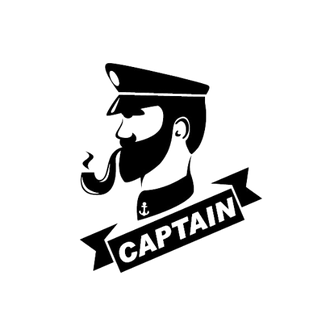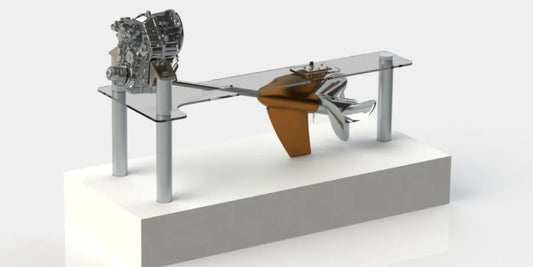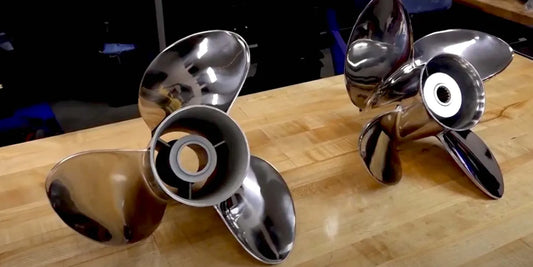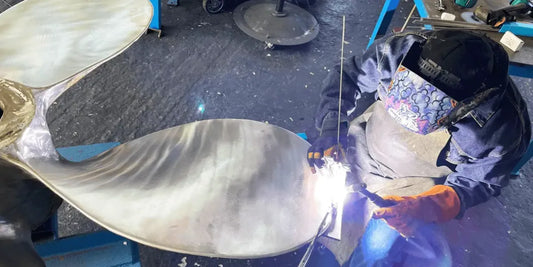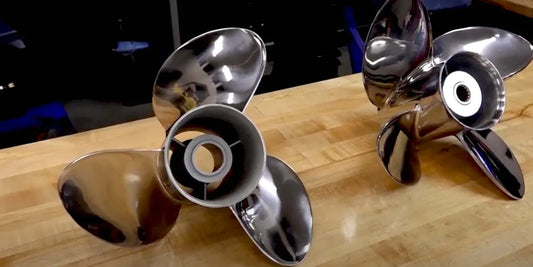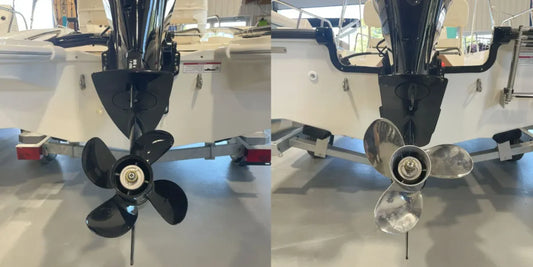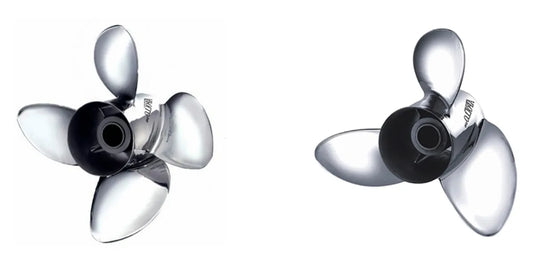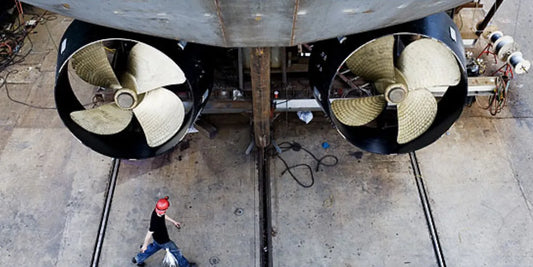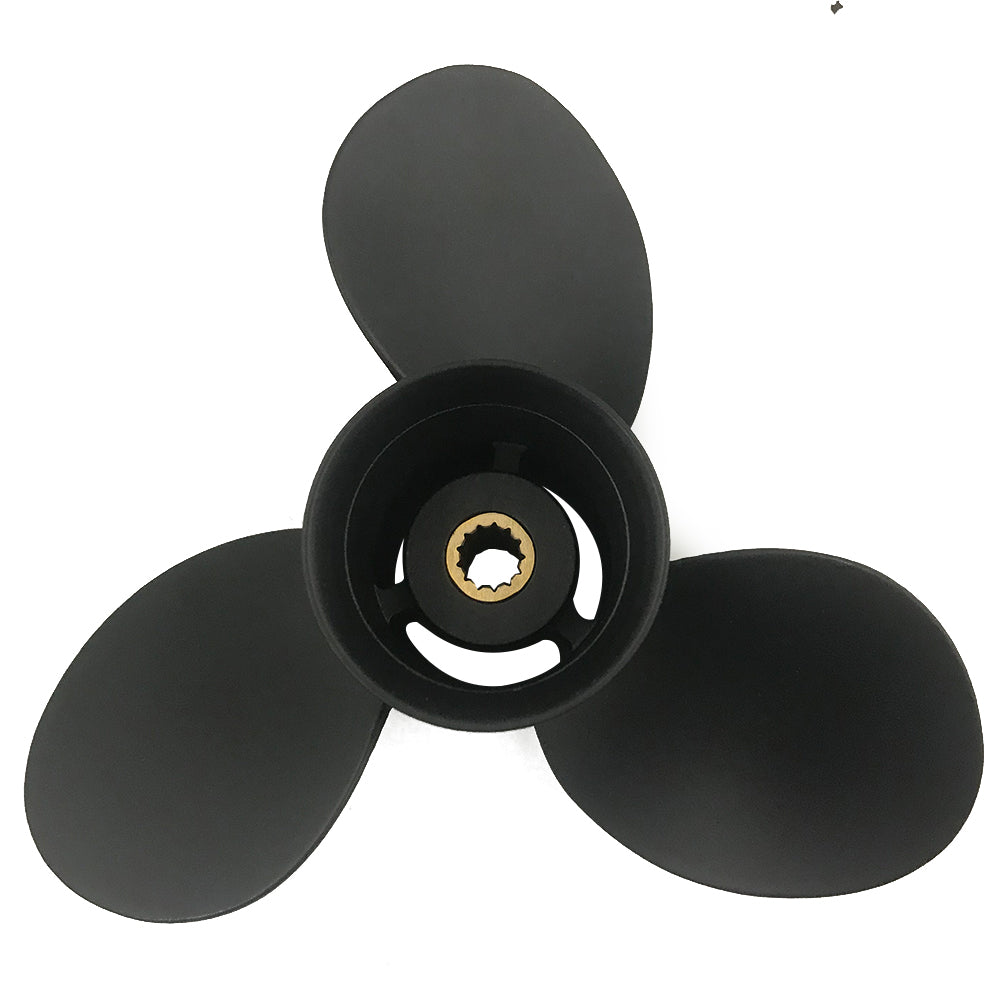Getting the right boat propeller is the most critical decision to ensure the best operating performance of a boat. Speed, fuel consumption, and handling are all factors in boat performance that depend highly on the propeller choice. This guide goes into the basics of selecting a propeller to help you understand technical factors and provide practical information to make an informed decision. From ideas of pitch and diameter to the kinds of materials and blade layouts available, this article will arm you with what you need to maximize your boat's performance and enjoy the boating experience.
Understanding Boat Props

What is a Boat Propeller?
The propeller is a mechanical device that generates thrust by converting rotational motion into linear motion, forcing a vessel's displacement in water. It consists of blades radiating from a central hub, designed to generate lift and propel the water backward. According to fluid dynamics principles, the backward thrust pushes the boat forward.
A standard modern propeller is designated according to pitch, diameter, and number of blades, each influencing propeller performance. For example, diameter is related to the amount of water moved, and pitch is the distance moved per rotation, i.e., factors regarding speed or power to be optimized. Propellers are produced out of many different materials, with stainless steel and aluminum being among the most common. These materials allow for either durability or adjustment in performance depending on user requirements.
With modifications in design and construction, modern props aim to eliminate cavitation (loss of thrust due to gas bubbles) and work more efficiently in varied water conditions. Knowing these factors will help the boater select the right propeller to balance speed, fuel economy, and carrying capacity for a smooth boating experience.
Types of Boat Props and Their Uses
Boat propellers, being the key to different performances of watercrafts, are classified depending on boating requirements and conditions. Below are the common types of boat propellers and the specific uses:
1. Fixed Pitch Propellers: Fixed pitch propellers are the most common type of prop, with the blades being positioned at a set angle. They are unusual for their simplicity, strength, and low cost. These unusual propellers are best fitted for recreational boats and thus are often used under general water conditions with a good balance between speed and fuel efficiency.
2. Adjustable Pitch Propellers: Adjustable pitch propellers allow the user to adjust the blade pitch according to operational statuses. This makes them perfect for those boats that usually vary under load or water conditions and are often the commercial or performance application, where efficiency and precision are paramount.
3. Stainless Steel Propellers: Stainless steel propellers are most suitable for high-speed or high-performance boats for their strength and efficiency. These can cut through water with the least resistance possible, ensuring maximum speed and fuel efficiency. The stainless steel propellers go into a category where the investment is high. Still, about all performance factors, longevity, and popularity among top-grade boaters, they rarely regret the purchase.
4. Aluminum Propellers: Aluminum propellers are lightweight, inexpensive, and easy to replace, making them suitable for recreational or entry-level boating. They are less strong than steel but would be fine for less-demanding situations such as freshwater environments or leisure activities.
5. Four-Blade and Five-Blade Propellers: These propellers are intended for increased thrust and smoother operation at low to mid-range speeds. They minimize vibration, which is ideal for water sports applications such as wakeboarding or skiing, where stability and acceleration are vital. Their fuel economy is also advantageous on long trips.
6. Ducted or Kort Nozzle Propellers: Usually found in tugboats or vessels requiring low-speed thrust, the ducted propeller runs within a nozzle that maximizes water flow. This increases manoeuvrability and towing power, making them productive for some heavy-duty operations.
7. Surface-Piercing Propellers: Surface-piercing propellers equip crafts for very high speed with part of their blades above water. This drag-reducing design is ideal for racing speedboats, where competitive performance is the main concern.
Knowing the advantages and applications of various boat propeller types allows boaters to select the proper combination for utmost performance, fuel economy, and working life of their watercraft. Using the proper propeller for the activity for which the boat will be employed can be a genuine boost to both the enjoyment and working life of the boat.
Importance of Prop Selection for Performance
The choice of a propeller can significantly impact how a boat performs in all areas of efficiency and duration of use. Pitch-size-material-blade count is a factor that individually caters to propelling, fuel efficiency, and speed. A higher pitch allows more speed but less acceleration, while the lower pitch prop is roughly the opposite, offering thrust and faster acceleration but less top speed. A stainless steel propeller, in comparison, is more durable and can manage a higher power rating, making it the choice for performance-grade boats. In contrast, an aluminum propeller weighs less and is inclined to cost less.
Also, the advanced hydrodynamic design helps performance by reducing cavitation and increasing efficiency. Recent data indicate a 15% fuel saving from a well-matched selection of propellers, in addition to the reduction of engine stress, which inherently favors a longer life for the engine. Knowing these factors and catering to a particular boating activity, be it fishing, cruising, or high-speed racing, will be a rewarding on-water experience for the boaters and a cheaper investment in future maintenance. The propeller choice is not merely a mechanical choice but rather a performance choice dictated by specific needs and conditions.
Factors to Consider in Prop Selection

Engine Specifications and Compatibility
The propeller must be chosen based on understanding the engine specs. These are essential characteristics: engine horsepower, RPM range, and gear ratio, all determining the propeller's performance. When well-matched, these specifications give a higher measure of fuel economy, better acceleration, and top speed. An outboard engine has been kept within its designed wide-open throttle (WOT) range, usually in terms of RPMs. Thus, selecting a propeller that allows the engine to remain in this WOT range will increase the engine's life and efficiency.
Furthermore, the diameter and pitch of the propeller change its compatibility with the engine and boat. A smaller pitch means better acceleration but less top speed, while a higher pitch helps top speed at the expense of acceleration power. Modern innovations like the interchangeable hub system also aid flexibility and make compatibility adjustments easier and more accurate. By adequately working through these parameters, a boat owner can align the propeller choice with performance targets to reduce mechanical stress and heighten their boating experiences.
Blade Design and Its Impact on Performance
The blade design of a boat propeller affects its efficiency, speed generated, and overall performance. Factors such as the number of blades, the shape of a blade, and its surface area directly impact how water interacts with the propeller. For example, a three-blade propeller is a good all-around compromise between speed and efficiency and is commonly used in recreational boating. More than four blades, however, raise thrust levels and smooth operation and would be used for heavier vessels or in towing.
On the other hand, the blade shape also influences performance and affects cup design and rake angle. A cupped blade enhances grip into the water at weaker forces, thus minimizing slip and maintaining control, especially at higher speed cases. A higher rake pushes the water back harder, improving lift and assisting in performance-oriented cases. Furthermore, new materials and hydrodynamic design have evolved to develop propellers with less drag, higher durability, and more fuel efficiency. Hence, by selecting a suitable blade designed for its specific working condition, a boat owner can get better performance, less wear, and a more pleasurable experience on the water.
Pitch: How It Affects Speed and Thrust
Pitch is one of the determining factors for a propeller's capability, affecting speed and thrust. It is the fundamental term that refers to the distance that the propeller should move forward during one revolution in the absence of slippage, and it has to do with the engine's power to be converted into the desired performance. A heavier-pitched propeller propels more water with each rotation and has greater speed potential. It requires a lot of engine power and is meant for lightweight boats, where top-end speed is a significant factor.
Conversely, a lower pitch propeller means better acceleration or pulling power, which is important when towing or heavy loading. It is of great consequence to keep watch on this balance to maximize the boat's performance for its intended use, considering the type of hull, the engine, and the load. For example, recreational boats for water sports prefer a lower pitch for downhole shots, whereas high-speed boats have a higher pitch for all-out speed. By adjusting all these factors, boaters can find that spot between speed, thrust, and efficiency, ensuring the propeller matches exactly what they want and need.
Using a Propeller Selector Tool

How to Use a Prop Selector for Optimal Results
First and foremost, one must gather pertinent details about the boat and usage requirements to use a propeller selector tool. Input information regarding the make and model of the boat, the engine type, horsepower, and the average load capacity will narrow down the possible selections and verify their compatibility with your vessel. Then, decide what you will be doing most: watersports, fishing, or general cruising. Accordingly, select the parameters that relate to those needs, such as speed range or thrust desired.
The propeller selector tool will then list the options based on your criteria and generally emphasize performance-related parameters such as pitch, diameter, and type of material. Some tools might even show predicted variations in RPM or fuel consumption levels, giving you that edge in decision-making. This recommendation should always be cross-verified with the manufacturer's recommendations and through the real-life experience of operating the propeller to prove it performs well. Adjustment and changes after practical use would guarantee that the propeller improves the boating experience while maintaining efficiency and speed.
Benefits of Utilizing a Propeller Selector
The propeller selector is instrumental in tailoring your boating experience toward precise vessel performance adjustments. A propeller selector enables you to evaluate pitch, blade diameter, material type, and number of blades to determine the best option for your specific boat and operational circumstances. This customized solution is an excellent method to enhance both speed and fuel efficiency, enabling peak performance by eliminating trial and error. Moreover, using a propeller selector saves time because it streamlines the selection process with its guided recommendations, based on technical specifications and real-world data.
The propeller selector also allows for variations in boating scenarios, such as load changes and water conditions. For example, a watersports craft may require a propeller that offers maximum thrust at lower speeds, while a cruising boat may be designed for high-speed efficiency. The selector tool can handle different contexts and process demands in search of optimal performance. In addition, improper propeller selection increases stress on the engine, reduces efficiency, and leads to potential damage to essential components.
Lastly, propeller selectors nowadays contain a combination of predictive analytics and state-of-the-art technical updates that make the issued recommendations extremely reliable. These tools stay relevant and dependable for on-the-spot decisions by framing the performance data alongside manufacturer specifications. Regardless of experience levels, a propeller selector offers an easy solution to complex calculations, thereby maximally increasing efficiency while amplifying one's confidence in arriving at an optimum outcome on the water.
Common Mistakes in Prop Selection
Choosing the wrong propeller can be challenging, with several common mistakes holding it back from performing at peak efficiency. One critical error is selecting the propeller without considering the vessel's general use or its load capacity: such an oversight creates a mismatch in performance relative to both acceleration and fuel economy, as well as handling. Other common issues include neglecting to consider the engine's recommended RPM range and causing the motor to underperform or sustain damage if the RPM range is not adhered to.
Improper material selection also plays a significant role; aluminum props may be cheap, but they are insufficient for the durability needed for high-speed applications or rough waters. In looking at price alone, buyers are sure to find inefficiency years down the line. Another common problem is not reevaluating their propeller's condition regularly, which means some wear and tear remains unnoticed, thus impairing performance and fuel economy. Avoiding these pitfalls will optimize their setups for improved reliability and enjoyment on the water.
Current Prop Analysis

Evaluating Your Current Propeller's Performance
Speed, fuel consumption, acceleration, etc., are the performance parameters based on your analysis of the current propeller. Suppose one assumes that the propeller works fine. In that case, the boat should be able to travel at its highest speeds without putting undue strain on the engine and stay within the recommended RPM levels given by the manufacturer. Fuel consumption is another key factor- an inefficient propeller often contributes to its being excessive, uneconomical, and environmentally harmful.
Smooth acceleration is essential, especially with heavy loads and under harsh conditions. Check the material and the design further. In general, stainless steel props usually offer better durability and performance over aluminum and others in harsh conditions. However, the environment might dictate the choice of material, though one has to be careful in shallow waters and debris-laden locations. Signs of wear and tear, such as cracks on the blades, bent blades, and corrosion effects, are to be looked out for to ensure performance at an optimum level and avoid sudden engine strain.
Record data from your recent trips: complete throttle RPM levels, the time taken to plane, and your handling experience. Compare with industry standards or manufacturer specifications for possibly requiring an adjustment or replacement. Keeping up with such performance checks can improve your boating efficiency while avoiding problems in the long run.
Signs You Need to Change Your Boat Prop
Performance, fuel economy, and even the life of your boat's engine may be affected if worn or unsuitable boat propellers are fitted. Recognizing the signs of a failing propeller is essential for keeping operations at optimal levels. One of the most documented signs would be a sudden drop in speed or the inability to reach a boat's full RPM at the top-end despite an adequately running engine. This mostly points to small degrees of propeller damage, improper pitch, or other related situations. Vibrations felt while moving may also suggest a bent or damaged blade that compromises its balance and efficiency.
Next, watch out for steady fuel consumption without observable gains in performance. This is when an inefficient propeller causes an engine to work harder, consuming more fuel. On the other hand, visible damage like cracks, dings, or corrosion indicates the time to replace. If your boat takes longer to plane or barely gets on plane, perhaps your current prop does not match your load or engine power. If your prop fits your particular activity, be it speed, tow, or fuel economy, you will notice greater performance and efficiency; thus, regular check-ups and replacement can spare you from long-term damage, save you money, and improve the overall boating experience.
Comparing Current Prop with New Propeller Recommendations
When considering what setting to use in your current propeller in contrast with new recommendations, performance indicators that affect boating experiences are paramount. Thus, pitch, diameter, and material choice affect efficiency and thrust. A higher-pitch prop may give more top speed, but it will put too much stress on your engine if not correctly matched with the boat's power and load capacity. In contrast, a lower pitch helps acceleration and towing, thus making it suitable for water sports.
In terms of materials, aluminum propellers are a cheaper option and are lightweight, suitable for casual boating, while stainless steel offers strength and performance, especially in heavy-duty applications. Modern designs also use advanced blade geometry to maximize water displacement, thereby reducing drag and increasing thrust.
Other things to consider are those parameters that outline the RPM range at WOT (wide open throttle), which is now supposed to be recommended by the manufacturer to guarantee engine performance and longevity. The careful comparison of WOT RPMs, pitch, and diameter allows a boater to identify the best upgrades that help promote function, fuel efficiency, and enjoyable boating time. Considering these factors, one would have a clue specific to his/her customized needs and boating styles.
Recommendations for Top Speed and Performance

Best Propeller Designs for Different Boat Types
For me, the choice of preferred propeller design for a given type of boat always starts with the consideration of the purpose of the propeller and the engine specifications of the ship itself. I promote using aluminum or three-blade stainless steel propellers for smaller vessels such as fishing boats or tenders. Such propellers are easy to handle, less expensive, and offer better acceleration and maneuverability- a perfect mix for negotiating shallow waters or making quick directional changes.
For good speedboats or high-performance craft, I tend to favor four-blade stainless steel propellers since they ensure excellent speed retention, smoother rides, and better handling at high velocity. They are apt for watersports or racing applications. Pontoon boats and cruisers generally favor larger diameter propellers. These props provide greater thrust at lower speeds and are more suitable for heavy loads or leisurely cruising, ensuring frugal fuel use and optimized engine performance.
In other words, the choice of the best propeller design will hinge upon the actual boat and its usage, combined with the engine's capacity. By closely identifying factors like the performance criteria, expected speed, and water condition, I will confirm that the propeller choice fits the vessel's requirements and improves its practicality on the water.
Top Propeller Recommendations for Maximum Performance
In my experience, certain propellers have a reputation for being top performers and working consistently at optimal levels: stainless steel and four blades. Well, stainless steel propellers are durable and suited for anyone who wants to see top performance under challenging conditions. Because they are very rigid and not as flexible as the aluminum ones, they provide quicker acceleration, top speed, and better fuel efficiency. If strength and fuel efficiency are your requirements, this is it.
Much faster is another way to define four-blade propellers; it is excellent for steering, keeping down stability, and providing vastly improved performance at lower speeds or while towing. They handle smoothly and get on plane quicker than the best grips in choppy waters, making them a favorite among recreational and sport boaters. So, by installing a stainless steel four-blade prop on your boat, you gain a nice cocktail of speed, fuel economy, and precision, which acts well in any water condition.
How to Optimize Your Setup for Speed
Right from the onset, having the right propeller for my type of boating is key to optimizing for speed. In my arsenal, best for speed is a three-blade propeller made of steel, preferably stainless steel, since it's very light and facilitates quicker movement through the water, thereby offering less drag on the water. Ensuring that the propeller's pitch and diameter have been determined concerning the engine's optimum RPM range enables the boat to be propelled to its highest speed without the engine being placed under undue stress. Another reason to check for dents and warping regularly is that these could consign the boat to slower speeds and diminished efficiency, no matter how minute the damage might be.
Unloading unnecessary weight is another significant step I take. The slightest extra weight must be removed from the boat, which can slow me down. Apart from this, I like to keep the weight evenly distributed so that the ship stays nice and balanced. A poorly balanced boat will block its full blast potential with drag. Of course, keeping an eye on the trim setting makes a rather big difference, as setting the trim right means the boat glides right on top of the water surface instead of plowing through it.
Last but not least, I never relax while watching the engine. It has to be well-tuned and maintained constantly: oil changes, new fuel filters, and good-condition spark plugs. Top-quality fuel and checks on the engine's cooling system are key in ensuring the motor performs at its peak. Together, they enable me to squeeze out every possible knot of speed for the boat while ensuring smooth and efficient operation in the water.
Reference Sources
- Prop Selector: Find the One for Your Boat - Mercury Marine
- Boat Propeller Selector Guide - Propeller Depot
- Boat Propeller Fit Guide - Go2Marine
- Prop Selection Guide - Minn Kota (Johnson Outdoors)
- Selecting the Best Prop is Crucial but Easy - Mercury Marine
Frequently Asked Questions (FAQs)
What is the correct propeller for my outboard?
Typically, the right prop for an outboard demands attention to numerous conditions, such as motor horsepower and the kind of boat. To finally select the best props for an outboard, consider the propeller's diameter and pitch since these two parameters can determine the boat's performance. Higher diameter usually implies more thrust at low speeds, whereas higher pitch offers more top speed at WOT. You must also consider whether to opt for aluminum or stainless steel propellers and think of what advantages a given type would provide in terms of durability versus performance. Consulting a propeller guide to select the correct prop size for your applications would be ideal.
How does the prop diameter and pitch affect the ability to accelerate?
The ability of your boat to quickly accelerate and perform well in particular ways depends heavily on prop diameter and pitch. The pitch would be the distance that a theoretically perfect propeller travels in one revolution and affects how fast the boat can get on a plane to reach the optimum speed. A prop with a low pitch will aid in quicker acceleration and thus serves better where a great hole shot is required. Increased pitch can also influence fuel economy and top speed. That is to say, the pitch should be balanced well because if too much pitch is given, the engine will drift from this area, causing increased RPMs with slight actual acceleration.
What factors contribute to finding the best performance combination for a propeller?
What you want to seek out to maximize performance depends on many things, like blade surface, the number of blades, rake, and cup. The blade surface concerns the propeller's ability to push the boat through the water. The number of blades will influence acceleration and top speed; more blades can reduce vibration and increase smoothness, sometimes at the cost of top speed. Rake is an angular measurement of a blade's inclination, helping to reduce ventilation and cavitation, increasing efficiency. Meanwhile, the cup adds lift at the blade trailing edge. Besides these, knowing your boat's weight, how high the engine sits, and under what conditions you generally operate your boat, such as cruising versus full throttle, will put you on the path for prop selection for your needs.
How does engine speed influence outboard prop performance?
Engine speed is essential for observing propeller performance regarding RPM and throttle setting. Increasing the throttle increases engine speed and thus the RPM at which the propeller is spinning. Therefore, higher engine speed leads to quicker acceleration and higher top speed, depending on the pitch and diameter you have chosen for your installation. If, however, the propeller's pitch is too high for the engine speed, your propeller tends to slip, which hampers the boat's performance. Keep an eye on your current tach and act accordingly by adjusting your prop size, so the engine reaches peak horsepower at WOT.
Why is it important to consider having a spare prop on board?
In the view of boaters who often venture into remote areas, a spare propeller is essential and must always be carried. A spare prop can save you if your primary prop gets damaged due to impacts with debris or submerged obstacles. Different pitch and diameter options can also offer flexibility for varying conditions and fine-tuning performance when cruising or towing. Having a spare prop guarantees that shifts in your boat’s performance needs can be compensated for quickly. Also, learning how to change and install props will equip you greatly in emergencies, making your boating safer and more comfortable.
